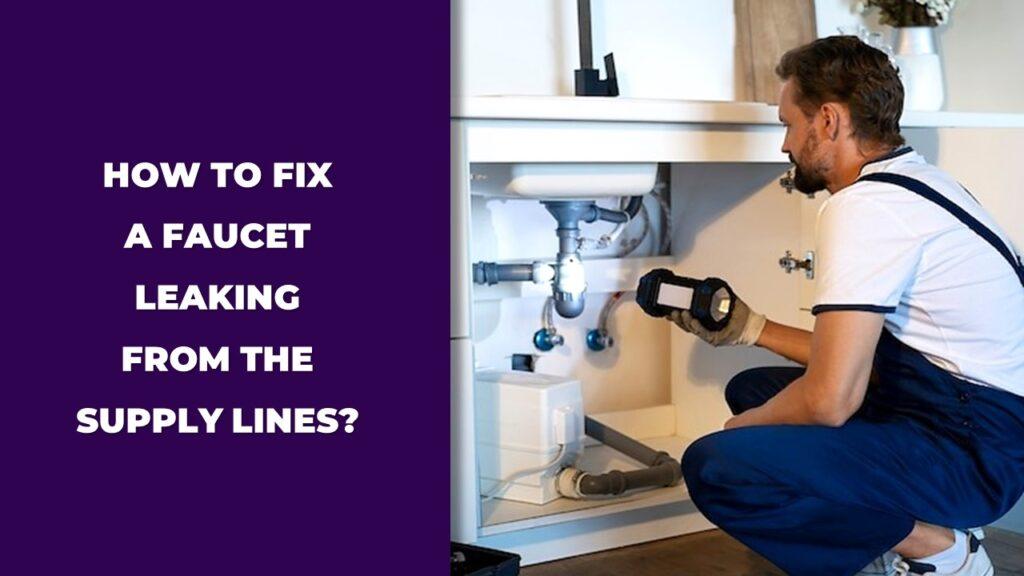
To fix a faucet leaking from the supply lines, first shut off the water under the sink. Check the connection points at the faucet and shut-off valves. Tighten the nuts gently with a wrench. If it still leaks, replace the supply lines. Remove the old lines, clean the threads, and install new ones using Teflon tape if needed. Turn the water back on and check for leaks.
This article will guide you through each step, explain why leaks happen, and help you decide when it’s time to call a plumber. It’s a simple, no-nonsense guide to get your faucet back in shape.
Why Is My Faucet Leaking from the Supply Lines?
Your faucet’s leaking from the supply lines because something’s wrong with the connection. Either the nuts are loose, or the line itself is worn out, or maybe it’s just too old. That’s really all it is. These lines don’t last forever. If they’ve been there a few years, the rubber inside might have dried up. Or someone tightened the nuts too much, and now the threads are messed up. Sometimes it’s just the washer inside the fitting that’s cracked. Point is—water’s getting through where it shouldn’t.
Let’s go over the usual reasons so you can figure out what’s going on under your sink.
Common Causes of Supply Line Leaks
The common causes of supply line leaks are:
- Loose nuts at the faucet or shut-off valve.
- Cracked, brittle, or bulging supply hoses.
- Worn-out washers or gaskets inside the connectors.
- Overtightened fittings that messed up the threads.
- Corrosion, especially if you’ve got hard water.
- Old lines that should’ve been replaced ages ago.
Signs You Have a Supply Line Leak
Some of the signs that you have a supply line leak are:
- Water pooling under the sink, yep, that’s the big clue.
- Damp cabinet walls, mold, or a musty smell.
- Drips from the connection points when the water’s on.
- The lines look old, rusty, or like they’re falling apart.
- You touch the lines, and they feel loose or wobbly.
Tools and Materials You’ll Need
This isn’t a complicated job, so you don’t need a ton of stuff. Just a few things that make it easier.
- A wrench or pliers, something to tighten the nuts.
- New supply lines, go for braided stainless steel, they last longer.
- Teflon tape for the threads.
- Towels or rags, you’ll need them, trust me.
- A flashlight, you won’t see a thing under there without it.
- A bucket, handy if water starts dripping when you disconnect things.
- Gloves, if you care about keeping your hands clean.
That’s about it. You can fix this yourself if you’ve got a little patience and don’t mind getting under the sink.
Step-By-Step Guide: How To Fix A Faucet Leaking From Supply Lines
Here’s a step-by-step guide to fix a faucet leaking from the supply lines:
- Shut off the water under the sink.
- Check the connections at both ends of the supply lines.
- Tighten the nuts gently, don’t go overboard.
- Replace the supply lines if they’re old or damaged.
- Turn the water back on, check for leaks, and you’re good.
Alright, let’s break this down so you know exactly what to do when you’re down there, looking at those pipes, wondering what went wrong.
Step 1: Shut Off The Water Supply
First thing, stop the water. You can’t fix anything while it’s still flowing. Look under your sink, you’ll see two valves, one for hot, one for cold. Turn them both clockwise until they stop. Then open the faucet at the top to let out whatever water’s left in the lines. That’s it, no fancy tricks. Just make sure the water’s off, or you’ll end up in a puddle.
Step 2: Inspect The Supply Lines And Connections
Now, grab a flashlight, get under there, and take a good look. See where the lines connect to the faucet? Check those nuts, feel them with your fingers, are they loose? Any signs of water around them? Follow the lines down to where they meet the shut-off valves, same thing, check for leaks, rust, or drips. And the lines themselves, are they cracked, stiff, or bulging? If they look like they’ve been through a war, that’s your problem.
Step 3: Tighten The Connections
If the lines seem okay, but water’s still leaking, try tightening the nuts. Don’t crank them down like you’re fixing a car tire, just snug them up with a wrench. Hand-tight first, then maybe a small turn with the wrench. If they’re already tight, don’t force it, there’s a limit before you do more harm than good.
Step 4: Remove And Replace Faulty Supply Lines (If Needed)
If the lines look bad, old, cracked, whatever, just replace them. Turn off the water if you haven’t already, grab a small bucket to catch any drips, then loosen the nuts and pull off the old lines. Wipe the threads clean. If they look worn or a little beat up, wrap them with Teflon tape, it helps seal the deal. Now, grab your new lines, screw them on by hand first, then finish with the wrench, just snug, not too tight.
Step 5: Turn Water Back On And Check For Leaks
Once it’s all back together, slowly turn the valves back on, one at a time. Watch closely as you do. Check both ends of the supply lines for drips. If it’s dry, great. Run the faucet for a minute, give everything a final check. If it’s still leaking, well, might be time to think about a plumber, but we’ll get to that.
Pro Tips To Prevent Future Supply Line Leaks
Most of the time, leaks happen because stuff just wears out. But you can save yourself a headache if you keep an eye on things. Here’s what I mean:
- Replace old supply lines every 5–10 years, don’t wait for a leak.
- Go with braided stainless steel lines, they hold up better than cheap rubber ones.
- Don’t overtighten, snug is enough.
- Every few months, do a quick check under the sink, look, feel, sniff for musty smells.
- If those shut-off valves feel stiff or don’t shut off right, think about replacing them too.
A little attention now means you won’t have a mess later. That’s all there is to it.
When To Call A Professional Plumber
Look, sometimes things don’t go as planned. If you’ve done the basics and it’s still leaking, it’s okay to call in a pro. Here’s when it’s worth it:
- You tightened everything and replaced the lines, but it’s still leaking.
- The threads on the faucet or shut-off valves look stripped or damaged.
- The shut-off valves won’t turn or they’re leaking too.
- You see water damage spreading beyond the cabinet, like the floor’s getting wet.
- You’re not sure what’s going on and you’re tired of messing with it.
A plumber’s seen it all. No shame in letting them handle it when it’s beyond a simple fix.
Common Faucet Supply Line Sizes (Quick Reference Table)
Okay, so when you’re replacing a faucet supply line, you gotta know the sizes. It’s one of those things you don’t think about until you’re under the sink, and by then, it’s too late. The two ends of the line aren’t always the same size, and you want to grab the right stuff before heading to the store.
Here’s a quick breakdown of what you’ll probably need:
| Supply Line End | Typical Size |
| Faucet Connection | 3/8″ Compression |
| Shut-Off Valve Connection | 1/2″ FIP or 3/8″ Compression |
| Common Lengths Available | 12″, 16″, 20″, 24″, 30″, etc. |
Don’t overthink it. Just measure the old line, check the ends, and match it up. If you’re still not sure, take it to the hardware store; they’ll help. Saves you a second trip.
Related FAQ
How long do faucet supply lines last?
Most last 5 to 10 years, but honestly, if it looks bad, just replace it; no point waiting for a leak.
Do I need Teflon tape when installing supply lines?
Yeah, you do, especially if the threads look a little rough or worn; it helps make a tighter seal and keeps leaks away.
Can I hand-tighten supply line connections?
Hand-tighten first, sure, but grab a wrench and give it a small extra turn; don’t go crazy, just a little more so it feels snug.
What size are faucet supply lines?
Usually, it’s 3/8″ compression at the faucet, and 1/2″ FIP or sometimes 3/8″ compression at the shut-off valve; check yours, though, older setups can be different.

Dylan Foster is a family man with years of hands-on experience in plumbing, household maintenance, and fixing everyday issues around the home. A former plumber, Dylan knows what it’s like to deal with tricky leaks, worn-out parts, and all the little problems that pop up in a house. From plumbing repairs to kitchen fixes and garden hose setups, he’s done it all. Dylan shares real-world solutions to help others keep their homes running smoothly and avoid costly mistakes.




